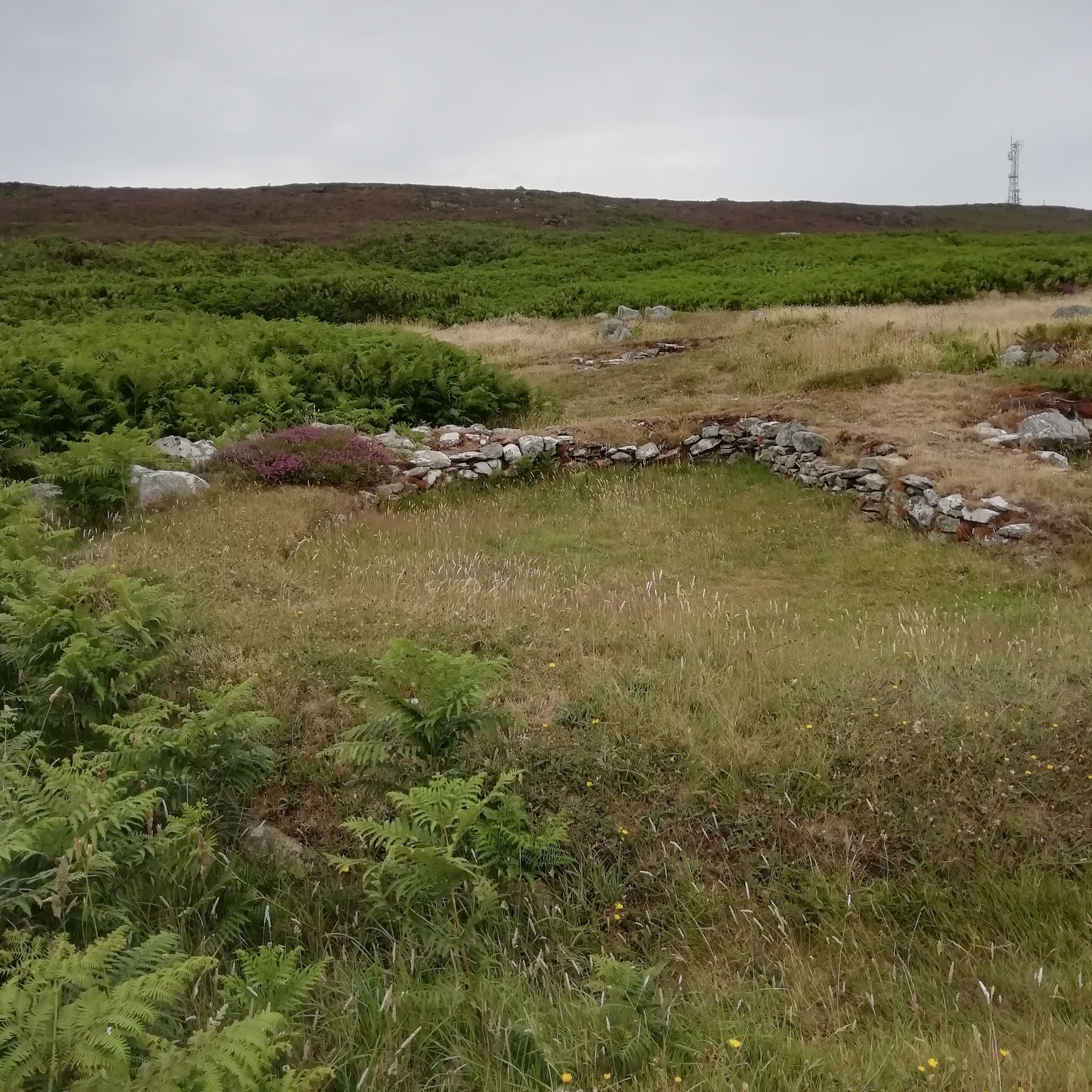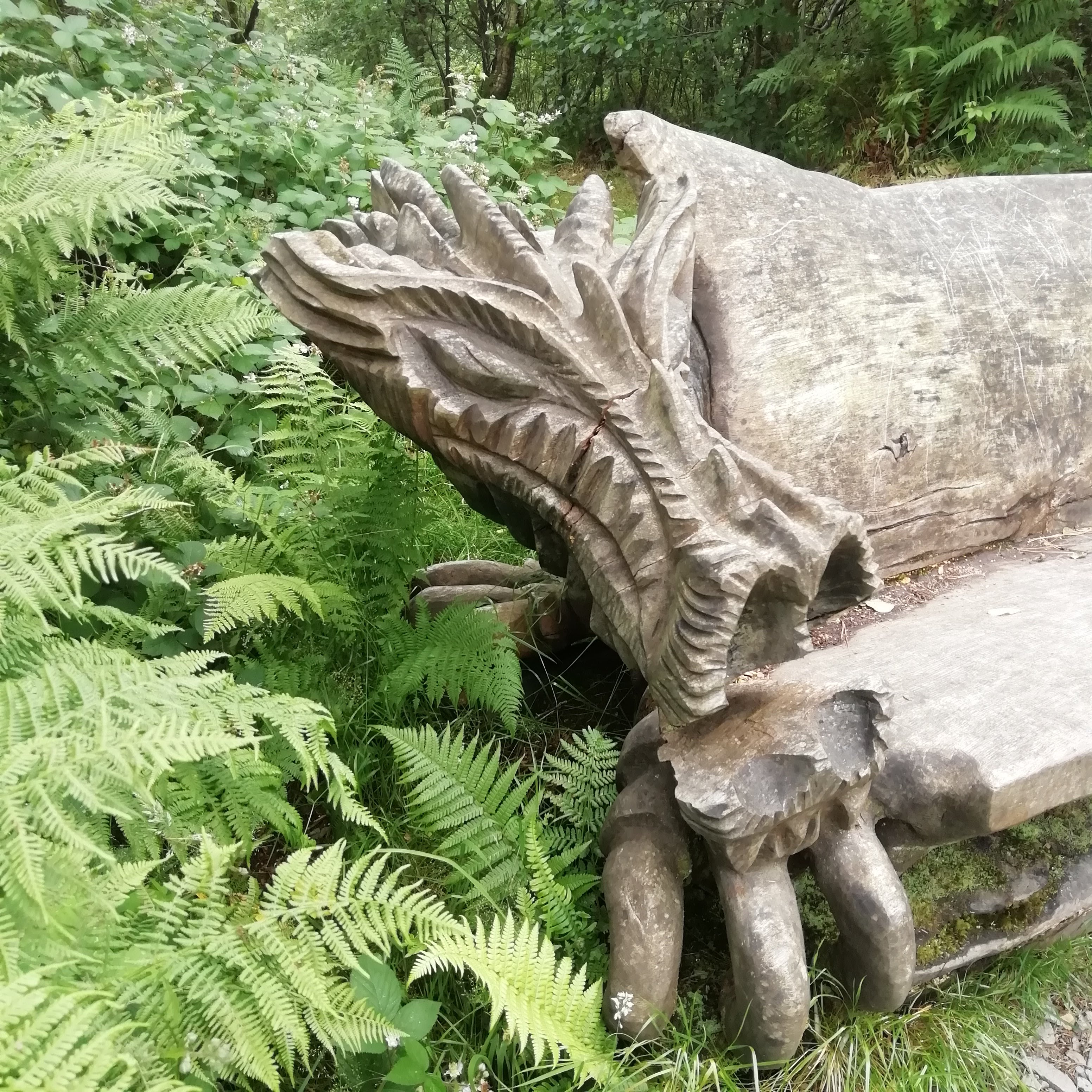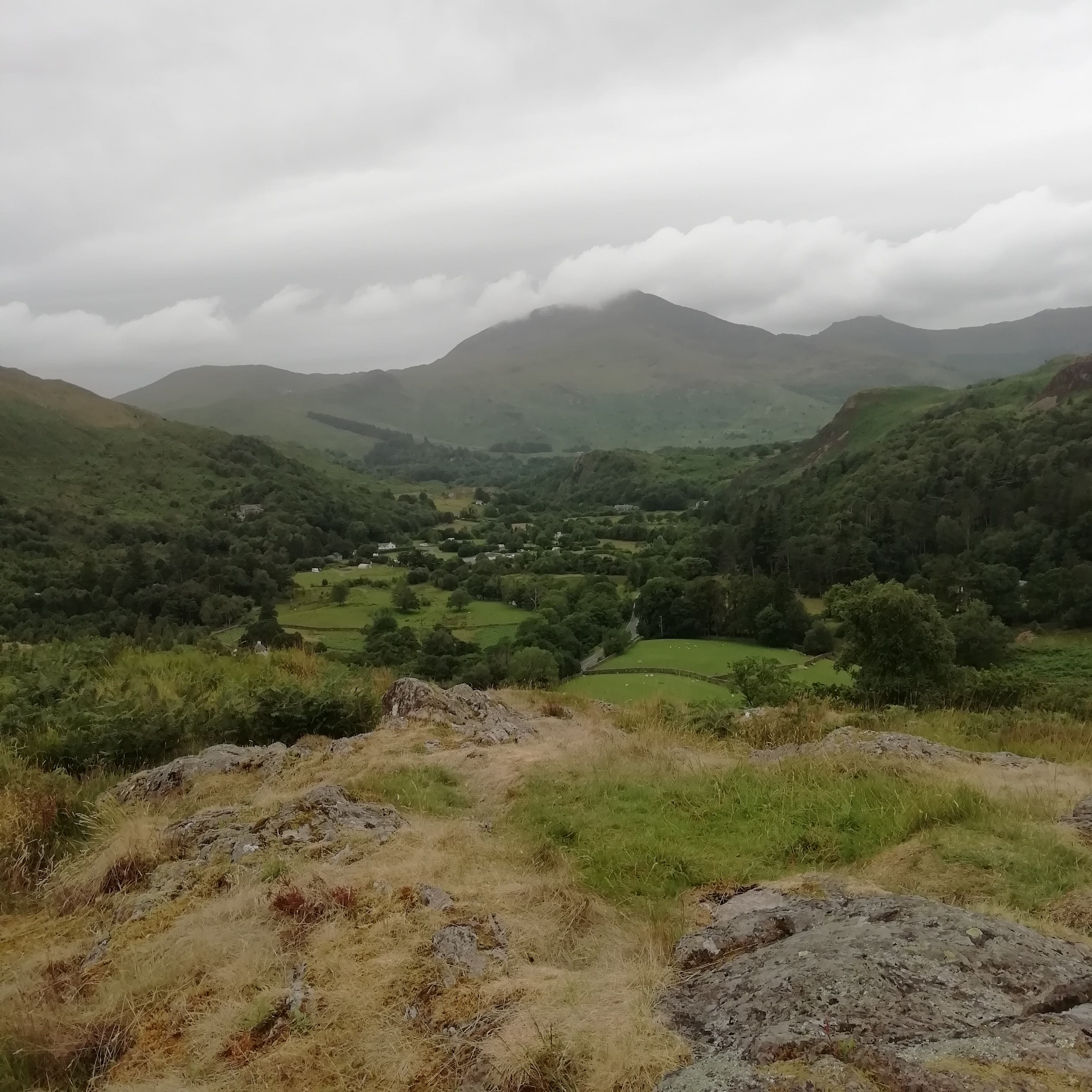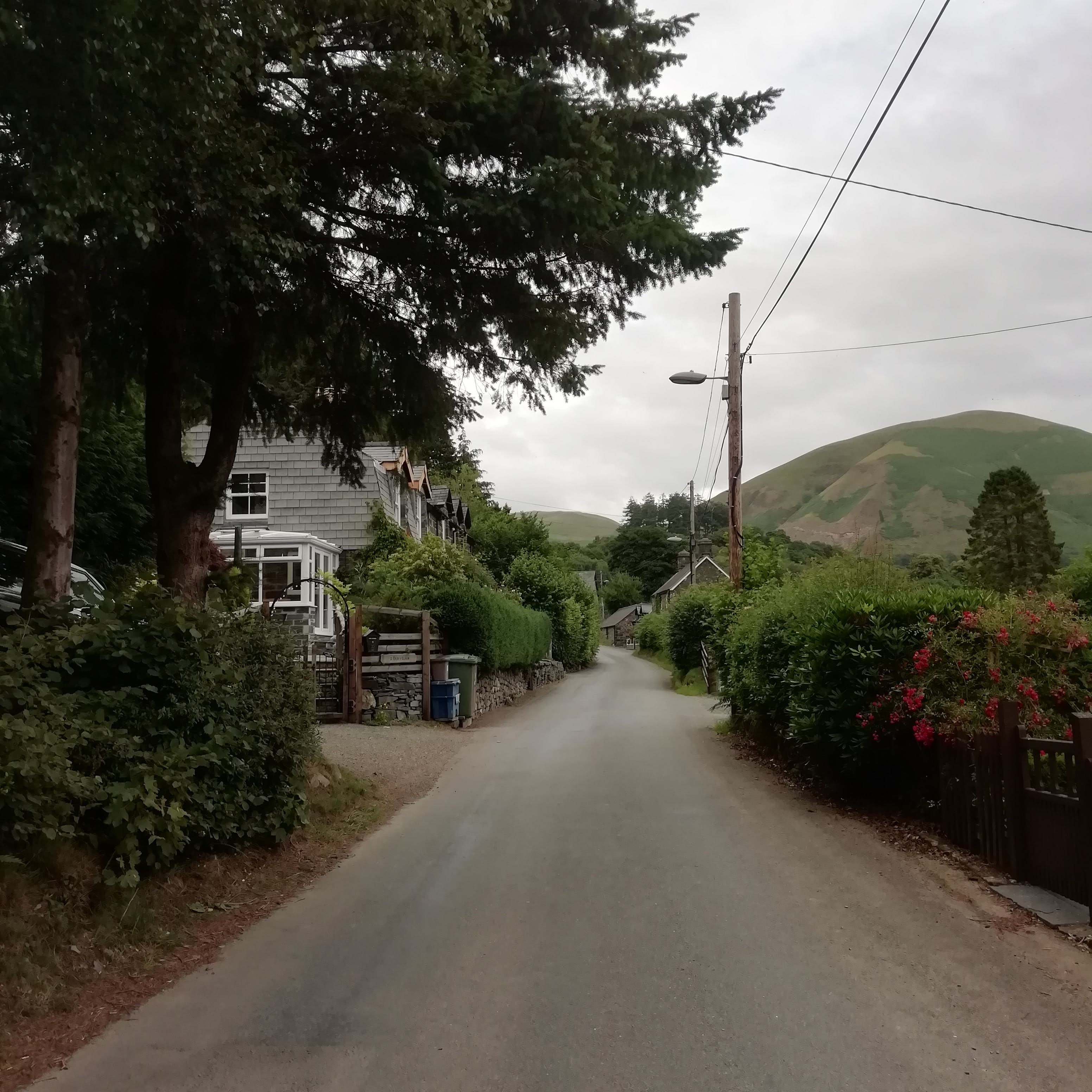My parents once came back early from a holiday in Wales because it hadn’t stopped raining. For years I carried this concept in my head that Wales was beautiful and full of mythology but always wet, so it was only recently that Mr W and I agreed it would be our next holiday destination. Mountains for him, legends for me. And in fact we were very lucky with the weather, only experiencing one wet and windy day, which was rather atmospheric for waterfall exploring.
Druids and Dolmens
Bryn Celli Ddu is a Neolithic burial chamber within an earlier stone circle. Its name means “Mound in the Dark Grove” but today it sits in an enclosure in a farmer’s field. On Summer Solstice the rising sun will shine directly from one end to the other, lighting up the chamber. What sort of rituals might have taken place here we can’t tell for sure, but these places always make me think of fairy tales like Kate Crackernuts (actually collected from Orkney) in which green hills are full of dancing fairies, the older, more capricious ones, not the flower fairies of children’s books.




Anglesey has a strong connection with the druids. The Romans determined to break their power. On their first invasion they were met with a wall of warrior, cursing druids and screaming, torch-wielding women, and had to be exhorted by their general to press on, defeat the army and destroy their shrines and sacred groves.

Wise Wizards and Wounded Kings
Deep in Snowdonia is Dinas Emrys, the location of Merlin’s debut. The story of the fort that wouldn’t be built is told by Nennius: Vortigern, a British leader who is regretting inviting the Saxons into the island, is taking refuge in Wales and means to build a fort in the mountains. But each night all the materials disappear. His advisors tell him he needs to sacrifice a fatherless boy and sprinkle the boy’s blood on the site to succeed with his building plan. Such a youth is found – Ambrose, or Emrys – who challenges the advisors to instead dig deep into the foundations. There, two serpents are found, one white and one red. They are the problem, says Emrys. They fight each night, which causes everything to collapse. The red signified the Britons and the white the Saxons. Geoffrey of Monmouth’s version is more elaborate: the walls fall each night, the boy’s mother explains how she became pregnant by an unknown night-time lover, and Emrys becomes another name for Merlin. Today, the red dragon roars on the Welsh flag.
We found a few dragons on our route up, and a waterfall, but on the summit there were only rocks and wind. We sat and looked out over the valley below, ringed in mountains. From a solitary house drifted party music.




Llyn Llydaw is one of the Welsh lakes that claims to conceal Excalibur, hurled into it by Bedevere when King Arthur was dying. It can only be viewed by booking a parking place at the start of one of the routes to Snowdon, or climbing Snowdon yourself, so Mr W saw this and I didn’t, because I don’t like mountain climbs. But Ynys Enlli/Bardsey Island on the Llŷn Peninsula has a claim to rival Glastobury as the site of Avalon, where Arthur sailed to be healed of his wounds.
The island is rich in history, from its abbey ruins to its own kings in the 19c. You can read more here.
We drove down the Llŷn Peninsula then walked the headland until the island lay before us. It wasn’t a hot day as temperatures go, but the walk was strenuous, with steep climbs and dips, the sun shone hard on the hillside and where the path crept through ferns the fronds held in the humidity. The view was worth it though, and for a change, we didn’t puff up an incline to find a sheep already there, watching us with mild contempt.


Owls and Flowers
Alan Garner’s folk horror The Owl Service is set in North Wales, and the TV series (available on Youtube) was filmed as close as possible to the original settings. In the story three young people, thrown together by a new marriage and a move, find a set of plates decorated with flowers – or owls – which awaken an old myth that is re-enacted in every generation, that of Bloddewedd, the maiden made of flowers who was turned into an owl for conspiring with her lover to kill her husband. The myth features in the Mabinogian. It’s a harsh tale of resentment, loneliness and revenge, and no-one comes out well. Garner turns it into a story of adolescent bemusement and the claustrophobia that comes from a holiday where there’s nothing much to do. It’s one of the books I admire most from those I read as a child (it wasn’t intended as YA, but is usually seen as such now.) I highly recommend it and the TV series.
Tomen y Mur is said to be the castle where Bloddewedd, made by the magician Gwydion as a mate for the hero Lleu Llaw Gyffes, looked down on the valley and fell in love with Gronw Pebr. A small brown sign pointed us across a field, and a short walk took us through a muddle of ruined buildings to a mound. Not as high as Dinas Emrys, but what a wide view of the lands around! Even the power station didn’t spoil the quiet, barely broken by the distant bleat of sheep. Historically, it was once a Roman fort, later converted into a Norman castle.



Garner set his book in Llanymawddwy, a settlement that involved an hour’s drive from our cottage, along mountain passes and threading through a valley. No pub here, or Spa shop. The chapel and the church are closed up, and we only saw one person, shutting his gates for the day. The mountains round here are greener and closer than the ones round Snowdon.

The Stone of Gronw, of uncertain age, is linked with the legend. Man-sized, it has a hole at the height of a heart, and through this Blodeuwedd’s husband pierced her lover and killed him. It wasn’t marked on either of our maps, so I was going by a website about British monoliths. We parked our car by the side of the road and walked up and down the farm track, but while we could see the river it was said to stand beside, there was no way to get there. I think it might have been moved.
Thank you for reading. If you enjoy folk and fairy tales, you might also enjoy this blog post about my favourite magical stories and modern takes on them.
Lynden Wade lives in England near a haunted wood and two castles. She writes about history, folklore and legends. She has had a number of pieces published in journals and anthologies or on websites: more details on her website but here’s one you can read for free.
NO AI TRAINING: Without in any way limiting the author’s [and publisher’s] exclusive rights under copyright, any use of this publication to “train” generative artificial intelligence (AI) technologies to generate text is expressly prohibited. The author reserves all rights to license uses of this work for generative AI training and development of machine learning language models.